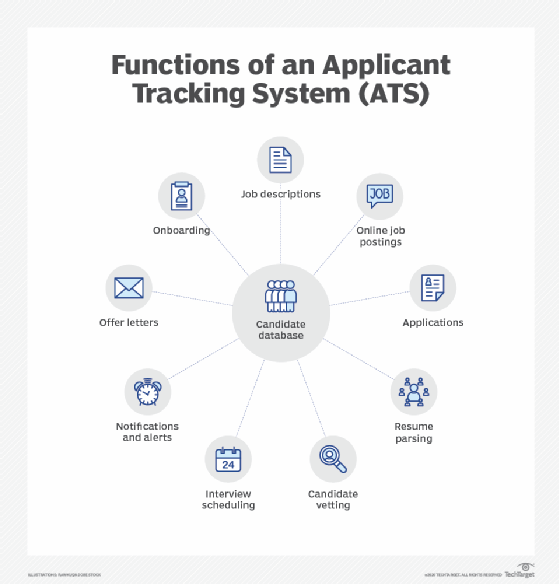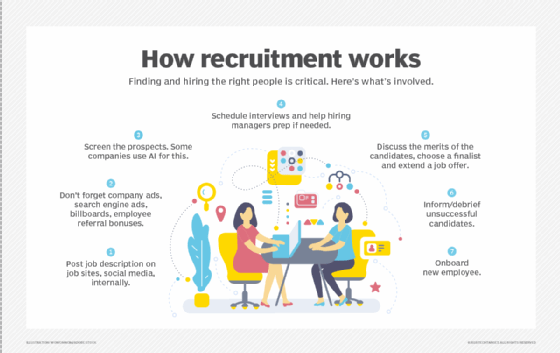recruitment management system
What is a recruitment management system?
A recruitment management system (RMS) is a set of tools designed to manage the recruiting process. It may be the most important core human resources (HR) system. Recruiting is competitive, especially for candidates with high-demand technical skills, and it is driving interest in sophisticated recruiting systems. These systems are being designed to improve the efficiency of recruiters as well as job seekers.
Recruitment management systems have a range of components and functions. They include applicant tracking systems for managing job postings and applications, and customer relationship management-type functions to keep applicants connected and engaged. Many of these tasks are automated. Routine tasks, such as scheduling phone calls and in-person interviews, comprise part of the work performed by these systems.
How do recruitment management systems work?
The line between RMSes and ATSes has become blurred, but an RMS generally supplements the functions of an ATS. Where an ATS is great at posting requisitions, tracking candidates and automating the employment offer process (see Fig. 1), an RMS goes several steps further by helping HR to engage candidates, automating additional manual tasks and improving the matching of candidates with open requisitions.
For example, in addition to posting open job requisitions, the RMS will simplify the posting of requisitions across multiple job boards and on social media.
For candidates, the RMS may let them apply directly from job boards or by using their profiles on platforms such as LinkedIn.

More advanced functionality can include ranking systems that use algorithms to analyze an employer's workforce. The technology may look at employee performance reviews, resumes and other records to identify the characteristics of a firm's most successful employees. These technologies rely on machine learning techniques to look for patterns in the data. This process informs the ranking system that employers use to select applicants to interview.
Recruitment software also deploys anti-bias technology to analyze job postings to flag words and phrases signaling gender preference, for example, which can discourage some applicants. The anti-bias technology is also applied to hiring. A hiring manager, for instance, may favor graduates of certain universities. The technology can exclude this limitation and help keep the focus on identifying applicants who best meet the job requirements.
Recruitment management systems are also getting friendlier. Applicants may see a chatbot on an employer's job page that's able to converse and answer questions, replacing a long and tedious FAQ section.
Ease of use for candidates is also a goal. The RMS may be able to parse a candidate's resume and pull out relevant information, such as work history and education, instead of the candidates having to manually enter information about themselves. Once the system learns a little about an applicant, it can suggest other jobs that may fit their skill set. The intent is to engage the applicant and keep them interested.
RMS features and capabilities
The advantage of an RMS over an ATS is that it automates many manual tasks, allowing the hiring team to focus on tasks that add value. An RMS also serves as a one-stop location for the hiring team to view all data related to the hiring process, including the job requisition, assessments, comments, candidate details and more.
Examples of RMS features and capabilities include the following:
- integrated applicant tracking system functionality;
- automated matching of candidates to open requisitions;
- chatbots to answer typical questions;
- CRM features to keep qualified candidates engaged with the hiring team;
- automated interview scheduling and integration with calendar software, such as Microsoft Office 365;
- integration with job boards, social media and other HR systems;
- advanced reports and dashboards;
- standard templates for letters, communications and requisitions;
- the ability to include third-party recruiters;
- candidate source tracking (employee referrals, job boards, etc.);
- improved data security, since all of the information is stored in one system;
- reminders for qualified candidates and hiring team members;
- employment agreements customized with the candidate's information and details captured from the job requisition;
- digital signature support using tools such as DocuSign;
- branding by region or country and to improve the look and feel of job postings; and
- integration with supporting recruitment tools, such as assessments and background checks.
What are the benefits of recruitment management systems?
One of the primary benefits of an RMS is its ability to offer all the functionality needed by a hiring team in one application, eliminating the need for additional talent acquisition and recruitment software. Everything from opening the requisition, maintaining regular contact with qualified candidates, tracking candidates in talent pools, and automating steps throughout the whole hiring process (see Fig. 2) is available in one application.

An RMS also provides all the information the hiring manager needs to make hiring decisions. This includes the candidate's resume, notes from the interview process, additional files and information provided by the candidate, pre-hire assessments, and comparison metrics based on other candidates who have applied. Depending on the specific RMS, the system may also rank candidates by employing advanced technology, such as AI and machine learning.
An RMS will often integrate with an onboarding application from the same vendor or the vendor of the core HR system. The integration provides a seamless experience for new hires and reduces the manual effort required of the HR team to set up a new employee in the HR system.
What types of companies should use RMS?
Small companies often migrate from highly manual processes that rely on email and spreadsheets to an ATS. As the recruitment process matures and the organization grows, they may want to take their recruitment to the next level and take advantage of the advanced functions offered by an RMS.
However, an RMS is often best suited to midsize and large organizations, since the software and implementation costs are often higher than with an ATS. There may be additional fees to implement advanced features, such as chatbots and resume parsing. Also, extra effort is required of the hiring team to manage the additional functionality, which may be difficult for a small recruitment team.
Another reason an RMS is best suited to large organizations is the volume of candidate resumes. As the number of candidates grows, the need for streamlined processes and automation also grows.
Market and costs of recruitment management software
Most products in the RMS and ATS markets are now cloud-based. The advantage of cloud deployment is that it reduces total cost of ownership by eliminating the need to maintain the computer equipment that the software runs on, and by making the vendor responsible for the work of securing the data, deterring hackers and managing software updates.
Prices of RMS and ATS applications vary significantly based on the amount and type of functionality provided. Small companies can often simplify their hiring process significantly by implementing an ATS, since it can automate routine tasks and help the organization move away from spreadsheets and email. For organizations with a significant amount of recruiting activity, an RMS may be more appropriate.
However, it's important to remember that the total cost of RMS software, implementation and potential third-party applications may be significant. Therefore, it is important to understand your requirements before investigating products to ensure you identify the options that meet your needs and budget.
Organizations looking for an RMS may also want to consider ATS vendors, since their applications may have many of the features of an RMS. In fact, some vendors may market their software as an ATS since the terminology is more common than RMS.
As for the broader market in recruitment software, there are numerous options to choose from. Many of the large human capital management (HCM) suite vendors offer recruitment software that includes an RMS.
There are also vendors who focus on RMS applications.





